What is an Alternating Current and Best Important Value
Table of Contents
ToggleIn the realm of electricity, Alternating Current (AC) stands as a cornerstone, quietly powering our modern world. This article delves into the depths of AC, exploring its fundamentals, historical significance, and the myriad ways it shapes our daily lives.
Basics of Alternating Current
at present, the generation, transmission, distribution and utised of large amount of electric power is done only through alternating current form. alternating means change magnitude and direction periodically and current means electric current.
the magnitude and direction of alternating current changes periodically with respect to time.in simple definition, in alternating current, electrons flow through a conductor from negative terminal to positive terminal, first in one direction then another.

its magnitude and direction is measured in terms of cycles. one cycle means, a sine wave moves through a complete rotation of 360 degrees. this can be well understood with the help of graph.
when the phase of alternating current cycle is devide into 360 equal parts is called degrees of phase.
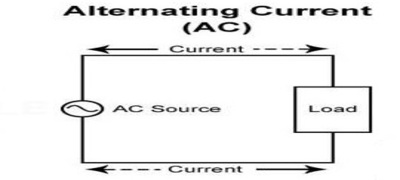
the current flow in the circuit for first half cycle in one direction and then other second half cycle direction reverse.the current which polarity and magnitude reverse again and again at regular interval is called alternating current.
at present time 90% of electrical energy used alternating current in nature.in alternating current,current increases in magnitude,first half cycle in one particular direction,achieve maximum and then stats decreasing to zero again second half cycle it increases in opposite direction and achive same.

alternating voltage is the voltage,which changes its polarity and magnitude at regular intervals of time.for example when alternating voltage is applied an load circuit.
Alternating Quantities
to understand a alternating current,some of its quantities have to be deeply understood
Alternating Current Waveforms-
alternating voltage or current vary with time t is called waveform. when plotting a graph, in which the instantaneous value of quantity is plotted against time.
Sine Wave
sine wave or sinusoidal nature is the most important of many waveforms of alternating current. sine wave means, direction of the current reverses at regular intervals. the curve is shaped between current-versus time, trigonomatric sine function.

the sine wave curve is completed when the coil rotates through an 360 degree.in sine wave induced voltage maximum at 90 degree position in first half cycle and again maximum but polarity negative in second half cycle.
alternating voltage and current are currently generated in variety of waveform,still engineers choose sine wave to adopt.the main reason for this is that incidentally,sine curves occur very commonly in nature.
some special advantages of using sine wave.
Some Special Advantages of Using Sine Wave.
- first the sine wave produces very little disturbance in an electric circuit
- using this,sine wave, the electrical equipement works at the highest efficiency without making any noise or disturbance.
- when applied to a sine wave electrical circuit, its output is also a sine wave for example.when sine wave voltage is applied in the primary of the transformer its secondary side alaways achive sine wave nature voltage.
- the mathematical expression of sine wave is also simple.
- using sine wave voltage and current curve low iron and copper loss in AC equipment.
- using sine wave voltage and current less interference to nearly communication system.
Square Wave
in square wave alternating current and voltage magnitude never changes but polarity changes.a square wave might have equal negative and positive part.
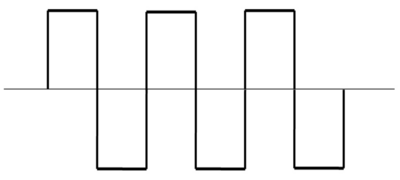
therefore it means its magnitude of voltage,current or power level constant figure shows a square wave,represented its positive and negative alternations are square in shape.
in this wave the current or voltage immediately reaches its maximum value and remains some period for the duration of alternation.the current and voltage immediately reaches the opposite peak value.
its pulse width is one half the period.this type of wave is most usefull in electronic signal purpose.
Irregular Wave
a trangular wave its peak positive polarity and negative polarity attained at fixed points in time.
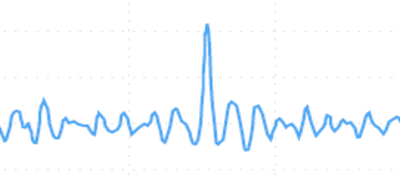
positive and negative peak the waveform alternately increases and decreases linearly with time.according to figure during positive first half cycle the waveform rises at a linear rate from 0 to it peak point and then decreases back to 0.
again during the negative second half cycle the waveforms rises at a linear negative direction from 0 to its peak point then return to 0.this type of waveform period measured from peak to peak point.
Periodic Wave
this wave regularly repeating at regular intervals. in electric circuits,periodic wave variying quantity such as voltage current or power with time.
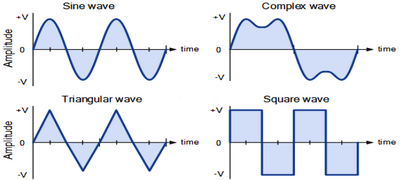
Sawtooth Wave
this type wave increase and decrease in straight lines.
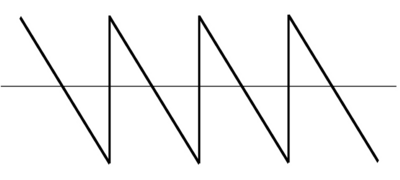
wave slope line indicates how the magnitude is changing.it use some electronic test device.this wave use for ideal signals for control purpose.this wave are two types
Sawtooth Wave Types
- first-rise, slow decay -- in this wave position rise is extremely steep, but negative fall is gradual
- Slow rise, fast fall -- this wave is just opposite to fast-rise slow decay wave. this wave shape use in television scanning this wave control electron beam to move
Instantaneous Value

the value of alternating quantity.at any instant in the wave is called instantaneous value. this value is represented for alternating voltage is e and alternating current is i
Cycle
in alternating quantity.one complete set of positive and negative value is called cycle. in other words one complete cycle is equal to 360 electrical degrees.
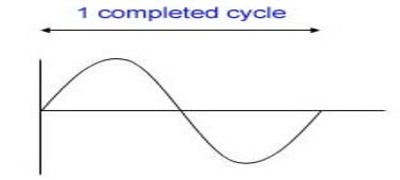
Time Period
an alternating quantity take time to complete one cycle is called time period. it is denoted by T and measured in seconds
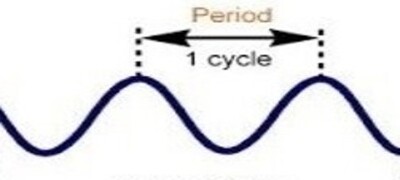
Alternation
one positive or negative half cycle of an alternating quantity is called one alternation.
another ways
one alternation spans = 180^{\circ } electrical degree

Frequency
the number of cycle that made in one second is called the frequency of alternating quantity. it is denoted by f. it ismeasured in cycle/second or hertz(HZ)
1 Hertz = 1 c/s
at present time frequency of power system used in 50 c/s or Hz.its means alternating voltage or current complete 50 cycle in one second.but in america frequency used 60 c/s or 60Hz
Amplitude
in one cycle, the maximum value attained by an alternating quantity is called amplitude or peak value or maximum value.
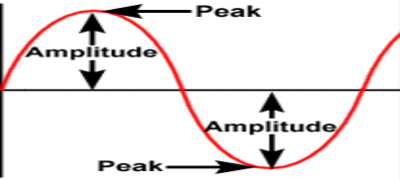
Phase
when an alternating quantity is the time that has elapsed since the quantity has last reach through zero point of refrence.
Phase Difference
two alternating quantities are said to be phase difference when they reach their maximum and zero values at the different.
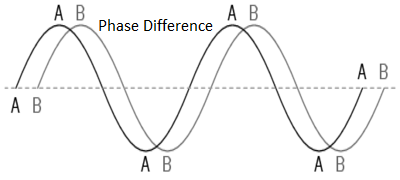
Angular Velocity
Angular velocity with which an object rotates at a fixed speed on a circular path. This is denoted by omega (ω). SI unit of angular velocity is radians per second.
Process of Generating Alternating Current and Voltage
an alternating current and voltage is generated by two process.
(i) It can be Generated by Rotating a Coil in Uniform Magnetic Field at Constant Speed
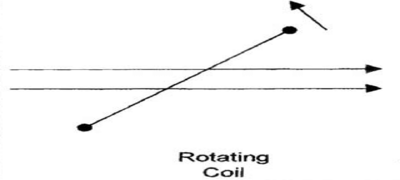
in this method only applied in small alternating current generator
(ii) It can be Generated by Rotating a Uniform Magnetic Field within a Stationary Coil at a Constant Speed.
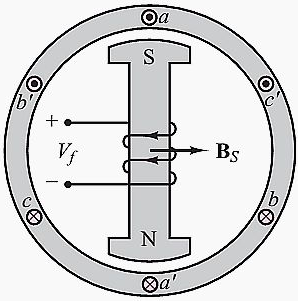
this method applied in large alternating current generator.both this method,the magnitude of generated voltage depends upon the number of turns of coils the strength of uniform magnetic field and speed of rotation.
both this process,magnetic field is cut by the conductor and an emf is induced according to the faraday‘ law of induction.the direction and magnitude of the induced emf depends on the position of the conductor coil
Let’s understand it Deeply.
when a coil p is placed in a uniform magnetic field and rotated anticlockwise direction at a constant angular velocity \omega radians per second.considering different positions at different instant in the rotation period.
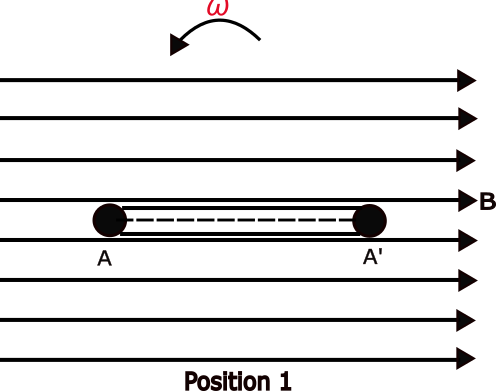

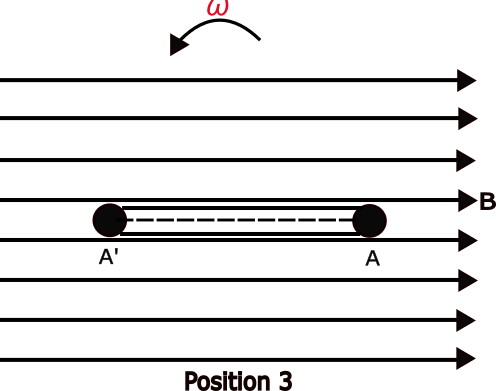
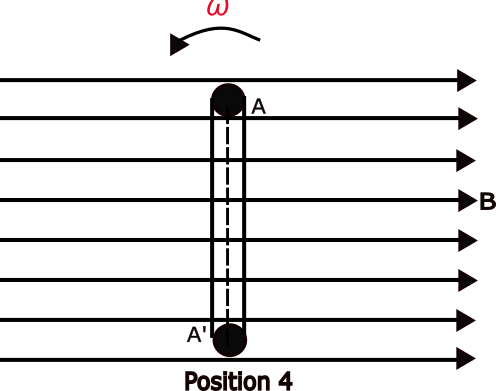
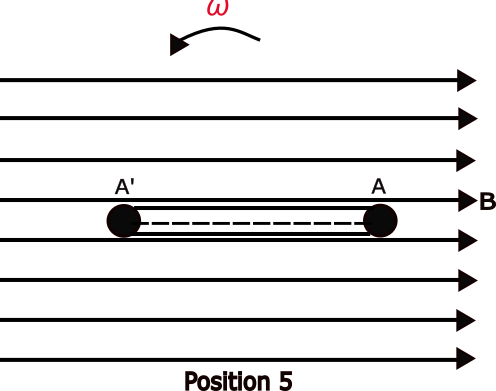
in figure at position 1
the conductor coil parallel to the magnetic field,therefore at this position rate of flux cut is zero so induced emf in this position is zero.
in figure at position 2
in this position the conductor coil moving perpendicular to the magnetic field,therefore rate of flux cutting is maximum,so magnitude of induced emf in this position is maximum.
in figure at position 3
the conductor coil parallel to the magnetic field therefore at this position rate of flux cutting is zero,so induced emf is zero.
in fugure at position 4
the conductor coil moving perpendicular to the magnetic field therefore rate of flux cutting is maximum but opposite direction.so magnitude of induced emf in this position is maximum.
in figure at position 5
the conductor coil parallel to the magnetic field therefore at this position rate of flux cut is zero so induced emf in this position is zero.
Equation of Alternating Current and Electromotive Force(emf)
according to faraday’s law of electromagnetic induction
where e = instaneous value of emf induced in the coil.
\phi=flux linking in the coil.
N= coil turns
t=time in second
now when a coil N turns rotating by some mechanical in a uniform magnetic field density B wb/m^{2} at an angular velocity of \omega radian per second.
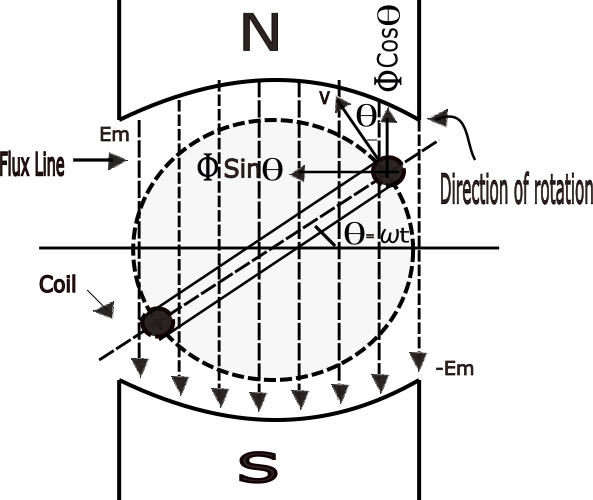
in figure (a) at this position coil linking maximum flux \phi _{m}.again in figure (b) after t second,the coil reached an angle\theta =\omega t radian.in this position flux linking with coil means emf generated two component.
first perpendicular the plane of coil component is \phi _{m}\omega t whereas the other component is parallel to the plane is \phi _{m}\sin \omega t
first flux links perpendicular the plane of coil component is \phi _{m}\cos \omega t
whereas flux links parallel to the plane of coil component is \phi _{m}\sin \omega t
according to faraday’s laws,the magnitude of emf induced at any instant this is called instantaneous value.
this value e=-N\dfrac{d\phi }{dt}……..(1)
put the component on equation (1)
then e=-N\dfrac{d(\phi _{m}\cos \omega t)}{dt}
=-N\phi _{m}\left( -\omega \sin \omega t\right)
=\omega N \phi _{n}\sin \omega t……(2)
emf e value maximum when angle \omega t = 90^{\circ }
then E_{m}=\omega N\phi _{m}
put this value on equation (2)
then e =E_{m}\sin wt
this emf when applied on any resistor,then alternating current i=I_{m}\sin \omega t flow in this circuit
Some Important Relation in Between
1.Frequency and Speed
one complete cycle is generated when a coil rotating at a speed of N r.p.m in the field of Ppoles.
so in definition
one revolution of the coil P/2 cycle are generated.
= (number of cycle / revolution) x (number of revolution / second
= (P/2) x (N/60)
frequency f = no of cycle /second
2.Frequency and Time Period
let alternating frequency f c/s and time period T second.
let for complete f cycles take time = 1 second
then for complete 1 cycle take time = 1/f second
but before we known one complete cycle take time c time period T
3.Frequency and Angular Velocity
when coil rotating with an angular velocity \omega rad/sec in uniform magnetic field.one complete revolution the angle turned 360^{\circ } or 2\pi and this 2\pi radian voltage wave complete one cycle.
again one cycle complete taken time period T of the alternating voltage.
angular velocity w = angular move/time taken
\omega=2\pi f (because f=\dfrac{1}{T})
Alternating Voltage and Current
magnitude of the alternating voltage and current vary from time to time.hence it can be expressed in four types of quantities.
Peak Value
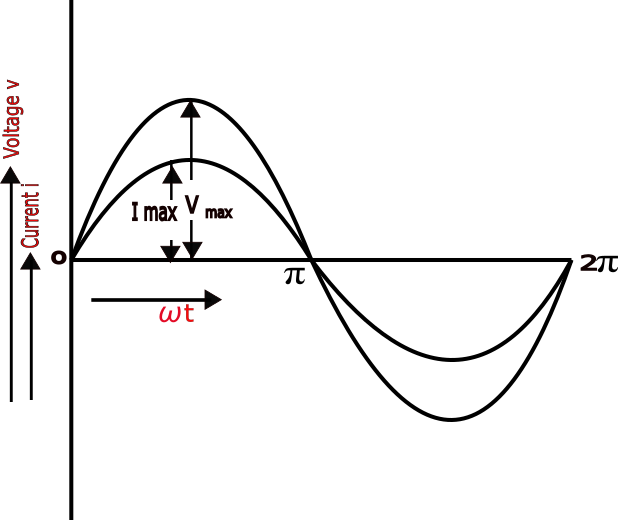
this is the maximum value of the alternating quantity it can be expressed for alternating voltage by V_{m} and alternating current by I_{m}.this value is important for testing of materials.
Root Mean Square or Effective Value
we find this value by comparing it with the heating effect.this value of alternating current or voltage cannot be measured directly.because its value over one cycle is zero.understand it in other words assume that a sinusoidal alternating current i flowing through a resistance R.
we know that the alternating current is varying therefore the heating of the resistance in the circuit will also vary.for this reason it becomes very difficult to find the root mean square or effective value.
therefore ,to find its value,we use a methode is for this,once alternating current is applied in the resistance circuit then direct current is applied in the same circuit,the condition is that both generate the same heat at the same time.
let i an alternating current flow through a resistance R for time t seconds.in figure shows half cycle of a non sinusoidal alternating current i.this half cycle devided into n equal parts so each duration
\dfrac{t}{n} second.
let i_{1},i_{2},i_{3}\ldots \ldots i_{n} be the mid ordinate
when alternating current apply the heating effect of various parts of alternating current will be
I_{1}^{2}\dfrac{Rt}{n}\ldots I_{n}^{2}\dfrac{Rt}{n} jouls.
total heat produce by alternating current
=\dfrac{\left( 1i^{2}R+i_{2}^{2}R+i_{3}^{2}R+\ldots \ldots +i_{n}^{2}R\right) }{n}t jouls
again heat produced by equivalent direct current I
= I^{2}Rt jouls
but both case same heat produced so
= root mean-square value of an alternating current.
root mean square value of an alternating voltage
Advantages of Alternating Current
The efficiency of AC transmission, coupled with its ability to control voltage, makes it a preferred choice in various applications. From powering homes to industrial machinery, AC’s versatility shines, contributing to its ubiquity in our technological landscape.
AC in Everyday Life
From the humble household appliance to large-scale industrial applications, AC is omnipresent. This section explores the myriad ways AC impacts our daily lives, often unnoticed but indispensable.
Household Appliances
Think about the appliances in your home – from the refrigerator and air conditioner to the microwave and television. AC is the silent force behind their operation. Its ability to change voltage levels makes it ideal for domestic use, providing a seamless and reliable power supply to our everyday gadgets.
Industrial Applications
Beyond the household, AC finds itself at the heart of industrial operations. Heavy machinery, manufacturing processes, and even data centers rely on the consistent and adaptable power that AC provides. This section explores the various industrial applications that owe their functionality to Alternating Current.
Challenges and Solutions
No technology can escape its challenges.AC systems face issues, and this section discusses technological advancements that address these challenges, ensuring a reliable power supply.
Issues with AC Systems
Common challenges include power loss during transmission, voltage fluctuations, and the need for extensive infrastructure. Acknowledging these hurdles is the first step towards developing solutions that enhance the efficiency and reliability of AC systems.
Technological Advancements and Solutions
In the quest for improvement, engineers and scientists continually develop innovative solutions. This section explores the latest technological advancements aimed at addressing the challenges faced by AC systems. From smart grids to advanced materials, discover how these innovations are shaping the future of electrical power.
Future Trends in Alternating Current
The evolution of technology never ceases, and Alternating Current is no exception. This section peeks into the future, exploring emerging trends that will further integrate AC into our lives and push the boundaries of what is possible.
Smart Grids and AC
Smart grids represent a significant evolution in the efficiency and sustainability of electricity distribution. Learn how AC is at the forefront of this revolution, enabling real-time monitoring, adaptive controls, and enhanced reliability in energy delivery.
Integration with Emerging Technologies
As technologies such as artificial intelligence, Internet of Things (IoT), and electric vehicles increase in prevalence, AC adapts to meet the evolving demands of our interconnected world. Explore the synergies between AC and these emerging technologies, shaping a future where electricity is not just a commodity but an intelligent and seamlessly integrated network.
Stay tuned as we unravel more layers of the Alternating Current landscape in the upcoming sections. From its environmental impact to practical tips for optimizing AC at home, we’ll cover it all.
